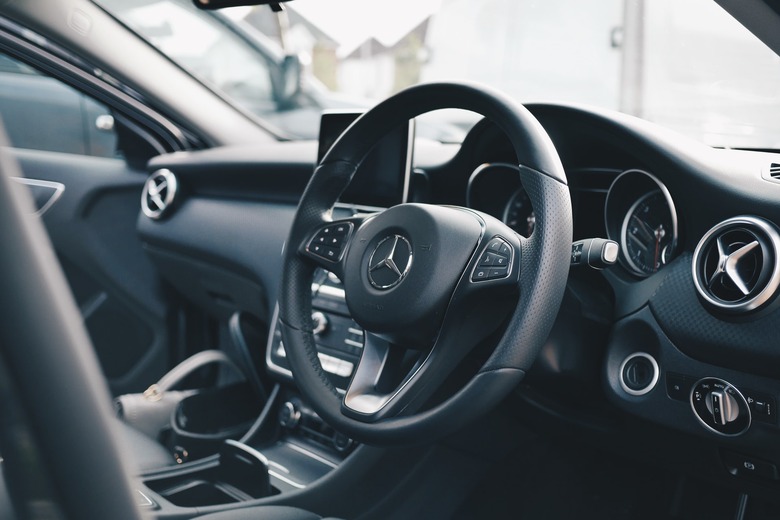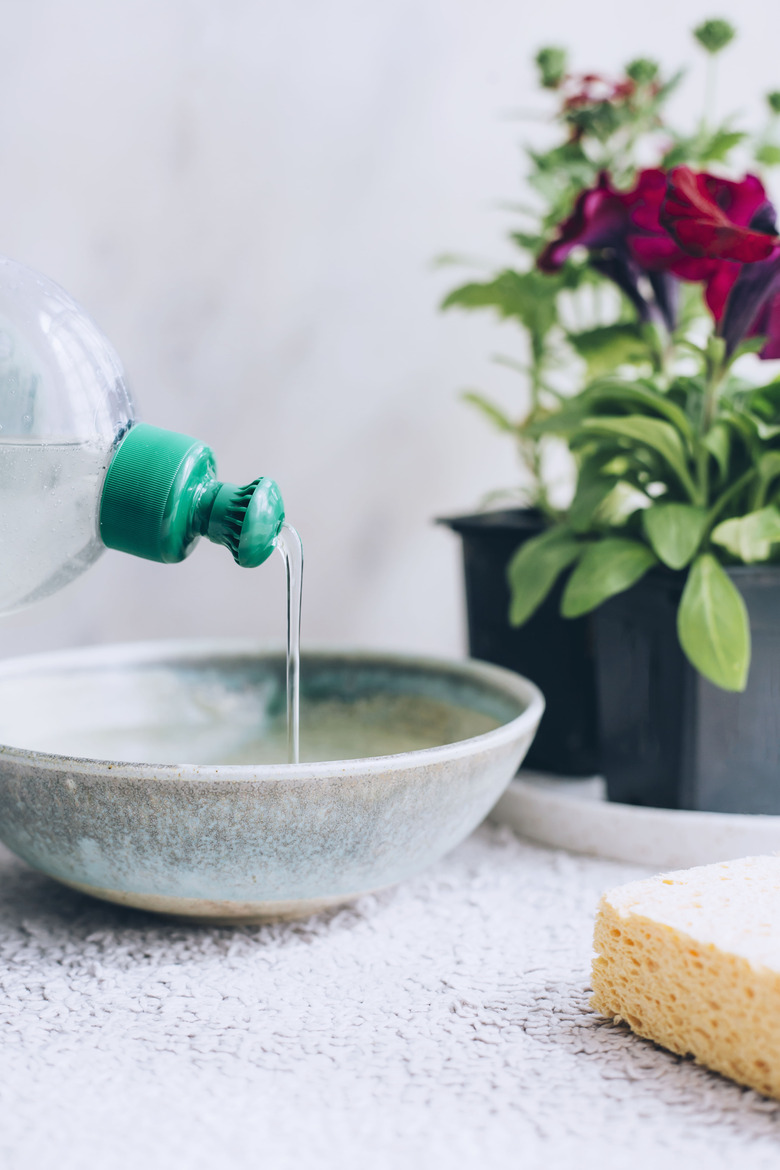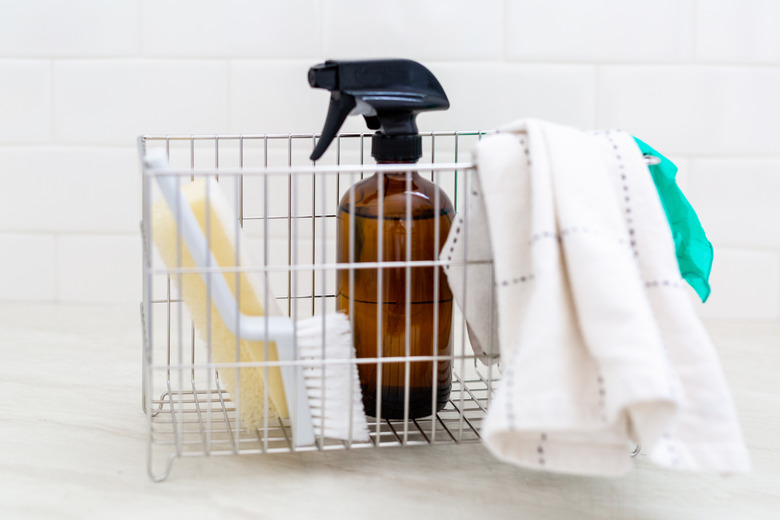Here's How To Properly Disinfect Your Car, According To The Experts
We may receive a commission on purchases made from links.
The typical car interior is 2,144 times dirtier than your average smartphone, according to a study conducted by Car Rentals LLC. As for an ordinary steering wheel, it was found to be four times dirtier than a public toilet seat. Taking these numbers into account, especially during the current coronavirus pandemic, it's important that we're all informed about the best way to clean and disinfect our vehicles.
Though you're likely not using your car as much — due to the CDC's quarantine and social distancing recommendations — you should still be ensuring that your car is clean and disinfected for necessary trips. Even if you run out for groceries, you should be certain that your car isn't contaminated. For the best advice on how to do so, we reached out to healthcare professionals and a car detailing expert.
How often should you clean your car, in general?
How often should you clean your car, in general?
When asked about how often you should typically clean and disinfect your car, Larry Kosilla — founder of car detailing company Ammo NYC and host of a popular YouTube channel on car detailing — tells Hunker, "It's recommended to do it based on how often you drive ... I think it's a healthy habit to do at least once or so every week or two. But if you have kids and you're lugging 15 people around, then you should probably do it more [often]."
He notes that it's important to both clean and disinfect the car, in accordance with the CDC's suggestions for households. Cleaning with soap, water, and friction will remove particles such as dirt and germs, whereas disinfecting with EPA-recommended products will kill germs.
How often should you clean your car during the coronavirus pandemic?
During the current coronavirus pandemic, you should only be using your car for trips that are absolutely necessary. With this in mind, Dr. Shan Soe-Lin — who holds a PhD in Experimental Medicine and a B.Sc in Microbiology and Immunology, both from McGill University, and a Master in Public Health degree from the Harvard School of Public Health — tells Hunker, "Ideally, you would disinfect your car every time before you use it or after the trip ends."
What car interior areas should you focus on?
What car interior areas should you focus on?
Dr. Tobi Schmidt, a personal health advisor and educator, specifically mentions the importance of disinfecting high-touch areas in the car. According to Car Rentals LLC's study, these areas include: the steering wheel, cup holders, seat belts, inside door handles, gear shifter, and audio volume controls.
How do you clean your car?
How do you clean your car?
First of all, you'll want to read your car's manual for the manufacturer's cleaning recommendations. Every car is different, meaning that you will want to use products that won't harm or stain the specific fabrics and surfaces inside your car. "You want to be sure you are using disinfectants that are compatible with various textiles/surfaces, such as hydrogen peroxide, quaternary ammonium compounds, and some phenolics," microbiologist Jason Tetro, author of The Germ Code, tells Hunker. "Always read the label to be sure you can use the product with your car."
Kosilla has a thorough, step-by-step video guide for cleaning and disinfecting your car during the coronavirus pandemic:
In the video, he recommends you use a cleanser that's specifically designed with car interiors in mind. When asked if you can also use soap and water, if you don't have such a cleanser, Kosilla says, "Soap and water is definitely something that can be done — it's better than nothing. You just have to be conscious of making sure you don't over-soak the area." Post-scrubbing, you can then scoop up the lather with a microfiber towel.
How do you disinfect your car?
How do you disinfect your car?
Once you're done cleaning and move on to disinfecting hard, non-porous surfaces in the car, Kosilla advises that you use an EPA-recommended product. (There is an EPA list of disinfectants specific to the coronavirus.) Again, you should read the label to make sure it's safe to use in the car. You should also ensure that you're not applying the product to a hot surface, which can cause staining and alter the product's drying time. "[You should test the product] underneath the steering wheel, on the backside, just in case something goes wrong," Kosilla advises, stating that you should do the same with anything you use on your leather fabrics.
"But it's not wipe and let it go," Kosilla says. "You have to let it sit for a specific amount of time. In some cases, you have to let it sit for 15 seconds to 20 seconds to sanitize, and three minutes to disinfect." Sanitizing refers to lowering germ counts to a safe level, whereas disinfecting involves the killing of nearly all germs.
For sensitive, porous surfaces, Kosilla states that he has not found a disinfectant that's safe to use across the board. For instance, when asked about rubbing alcohol, he states, "Rubbing alcohol would be really bad — that would just remove the color on the interior." Instead, Kosilla deep-cleans these surfaces and then tests an EPA-recommended disinfectant wipe to make sure it won't stain or lighten any fabrics. Again, make sure you're reading the manufacturer's instructions and all your product labels.
"If people are concerned about fabric seats becoming contaminated, they can be covered with a machine-washable cover," Schmidt notes. "Laundering the covers with normal laundry soap and hot water will disinfect them."
What about touchscreens?
What about touchscreens?
For touchscreens, Kosilla says, "The best thing you can do right now is to clean with a little bit of a non-ammonia, basic window cleaner. Spray it on some microfiber towels — just lightly mist. You never want to spray something directly on the screen." He adds that screen-specific cleaners will also work. If you don't have these items on hand, Kosilla says you can use a light mist of water on a microfiber towel to clean fingerprints off. "By no means are you disinfecting anything at that point," he states," but you are doing something that's better than nothing."
What kind of protective gear should you wear?
What kind of protective gear should you wear?
Describing what he wears when cleaning and disinfecting cars, Kosilla says, "Gloves, safety glasses if possible, [and] wearing long sleeves is always a good idea. A [face] mask for sure." Wearing protective gear such as a face mask and gloves is especially important so that you don't risk self-contamination. They can also prevent you from breathing in and directly touching potentially harmful product chemicals.
What other precautions should you take?
What other precautions should you take?
If you must use your car, make sure that you're wearing clean gloves or washing your hands before and after use. You can also bring along a bottle of hand sanitizer if you won't have access to soap and water during your trip.
You might be forgetting about another important part of your car: the keys. Just like with your car, make sure you are cleaning and disinfecting your keys before and after each use.
Lastly, in Kosilla's video, he emphasizes that you must exercise caution at the gas pump. Do not touch the pump handle or buttons directly — use a glove, wipe, or whatever else you have on hand. According to Car Rentals LLC, the gas pump handle is 11,835 times germier than a public toilet seat.
The takeaway: Clean and disinfect your car. Soap and water, along with a microfiber towel, will work for cleaning. In terms of disinfecting, follow the EPA's recommendations along with your car manufacturer's recommendations. Always read the product label and test the substance on a small part of the car fabric before use.



